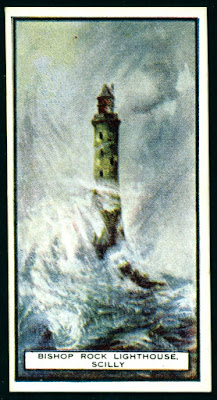It is hard to
believe that Doreen Carwithen’s dramatic Overture: Bishop Rock has been
largely ignored by concert promoters and record producers. An internet search on NewsBank
revealed a single performance of this work over the past 22 years. There may
have been others that have not shown up in the search.
This performance
was part of a concert given at St Oswald’s Church, Askrigg, North Yorkshire on
Sunday 16 June 2013. The Richmondshire Orchestra was conducted by Tim Jackson.
Several works were featured which ‘celebrated the diversity and beauty of the
British landscape’ including Gustave Holst’s Somerset Rhapsody, George
Butterworth’s A Shropshire Lad: Rhapsody for orchestra, the Second Suite
of English Folk Dances by Ernest Tomlinson, Edward German’s Three Dances from Nell
Gwyn and the Scottish Dances by William Alwyn. The final work at
this concert was Hamish MacCunn’s masterly Overture: The Land of the
Mountain and the Flood. The reviewer
from the Darlington and Stockton Times (2 July 2013) noted that the
‘journey began at the edge of the Isles of Scilly with Bishop Rock by
Doreen Carwithen, an overture describing the stormy seas around the lighthouse
in the bleak waters of the Atlantic.’ It is a succinct description of this
work.
Doreen Carwithen
was born in Haddenham, Buckinghamshire on 15 November 1922, and after music
lessons from her mother, she entered the Royal Academy of Music in 1941.
It was at this time that she met William Alwyn, who was her ‘harmony teacher.’
In 1947 she took up an apprenticeship offered by J. Arthur Rank to study and compose
film music. Over the years she produced several scores for the concert hall and
the recital room. However, as Martin Anderson (MusicWeb International, 3
April 2003) has pointed out in his obituary of Carwithen, she found it
virtually impossible to find a publisher willing to promote music written by a
woman.
In 1961 Carwithen
set up home with William Alywn in the lovely Suffolk town of Blythburgh. She
gave up composing and concentrated on supporting William’s music and acting as
his amanuensis and personal secretary a cause she maintained until the end of
her life. After her husband’s death in 1985 she began to re-examine her own
music and sketched out a third string quartet: this was never completed. Once married
William Alwyn, Carwithen began to use her middle name, Mary, as she had never
liked Doreen. Mary Alwyn died on 5 January 2003.
Doreen Carwithen’s
music has been recorded on several CD including two from Chandos and one each
from Dutton Epoch, Lyrita and SOMM. These include virtually all her major
works, including a good selection of her film scores.
The Overture: Bishop Rock, composed
in 1952, is a splendid seascape on a par with Mendelssohn’s Fingal’s Cave
and Arnold Bax’s Tintagel. The work is predicated on a musical evocation
of the Bishop Rock lighthouse which is located a few miles from St Agnes Isle
in the Scillies, and more than 30 miles from Land’s End. It is almost the
westernmost point of England, however, the actual location with that
distinction is Crim Rocks just one and half miles nor’, nor’ west of Bishop
Rock. The liner notes written by the composer for the Chandos CD (CHAN 9524) eloquently
explain that ‘this lonely tower is the last sight the seafarer has of land,
and, to the traveller from the New World, is a symbol of welcome after the
bleak waters of the Atlantic.’ How true this must have been for generations of seafarers,
and most especially those who had sailed during the Second World War and the
Battle of the Atlantic. This was a very recent memory when Carwithen penned her
Overture.
The entire work, which lasts for just
under nine minutes is an ‘impression of the thoughts stimulated by the
lighthouse and depicts Bishop Rock in both storm and calm’ (Carwithen op.cit).
The music begins with agitated horn motifs which immediately suggest stormy
weather. This may be musical onomatopoeia for the flashing of the light over
the sea or even Morse Code. The storm music continues, but soon resolves into a
long cantilena on the violins accompanied by the French horns. Slowly, this gorgeous tune builds to an
impressive climax, before brass interjections announce that the storm is just
about over. Now, the score begins to reflect a calmer sea, with the water
lapping against the rocks. This is a perfectly tranquil moment. But it cannot
last. At about the ‘5-minute mark’ a disturbing undercurrent is heard in the
low strings, which begins to take over the progress of the music. The storm has
returned in all its power and vigour. There is the inevitable recapitulation of
the elegant second theme before the work closes with some strident chords. Listeners who know Carwithen’s earlier music
will consider that the language here is ‘craggier’ and more dramatic. This
surely befits the subject matter of this overture.
In 2006 Goodmusic (Concert Originals
GMCO076) published the full score and parts for the Overture Bishop Rock.
The work is scored for 3 Flutes (3rd
doubling piccolo), 2 Oboes, Cor Anglais, 2 Clarinets in Bb, Bass Clarinet,
Bassoon, Contra Bassoon 4 Horns in F, 3 Trumpets in C, 3 Trombones, Tuba,
Timpani, Percussion (Snare drum, Xylophone, Tambourine, Triangle, Cymbals),
Harp, Strings (Violin 1, Violin 2, Viola, Cello, Double Bass).
Doreen Carwithen’s Overture: Bishop
Rock can heard on YouTube. (Accessed 08/09/2019) Part II of
this essay will examine the premiere performance and the single recording of
this work.

1 comment:
Thank you very much for posting this. I subscribe to the Rodders music channel, which has posted several works, this included, on YouTube. I'm adding a brief comment to it, mainly to direct listeners here.
Post a Comment